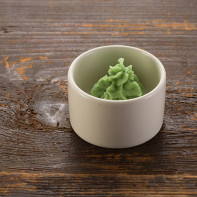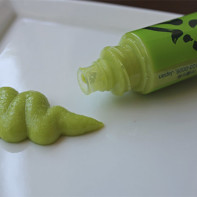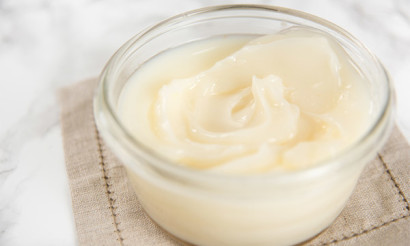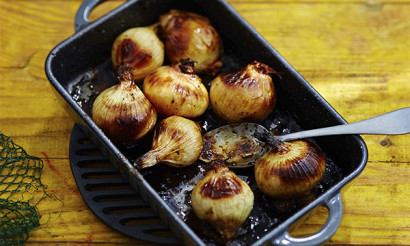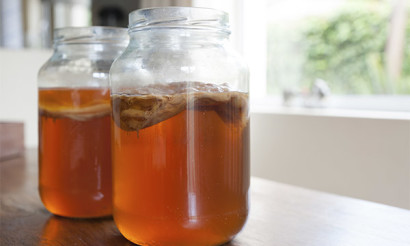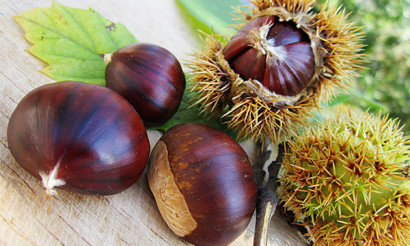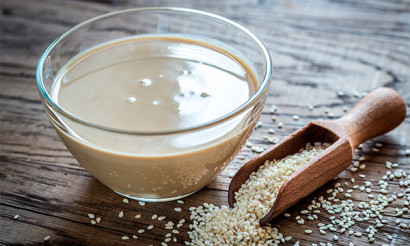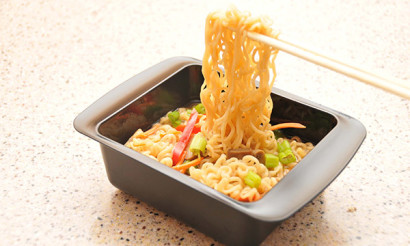Wasabi: health benefits and harms
First of all, this is a plant, and then - the Japanese sauce of the same name. Eutrem Japanese - the second name of a vegetable from the Cruciferous family, the main part of which is the root. Above the ground, you can see a slightly raised creeping stalk no more than one and a half meters long. Spring and summer - the time of flowering of the eutrem with small white flowers.
- What is wasabi and what is it made of
- How wasabi differs from mustard and horseradish
- Composition and calorie content
- Useful properties of wasabi
- For women
- For men
- During pregnancy
- When breastfeeding
- For kids
- When losing weight
- Wasabi in medicine
- Wasabi in cosmetology
- For face
- For hair
- Cooking use
- How can you replace wasabi
- Harm and contraindications
- How to choose and store wasabi
- How to make wasabi at home
- Interesting Wasabi Facts
The place of growth is the mountain prefecture of Shizuoka, rich in rivers. Running water, its temperature in the range of 10-17 degrees throughout the year - the necessary conditions for growing plants. Hot springs serve in some farms to maintain the temperature regime. Before the full maturity of the root crop, 18 months pass. After this period, the root becomes the raw material for the preparation of natural sauce.
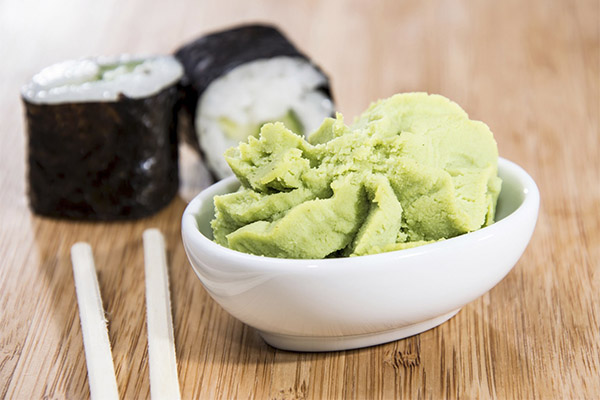
On a note! If earlier this root grew only on the mountain slopes of the Japanese prefecture, now New Zealanders, residents of American Oregon and Taiwan have learned to grow it.
What is wasabi and what is it made of
This mysterious seasoning is familiar to admirers of Japanese cuisine: if sushi appears on the table, a bright green hot pasta is certainly nearby. Japanese sauce has become a favorite seasoning for gourmets in many countries due to its fast cooking and lack of additives.
The mature root, thick and juicy, is torn off and ground on a grater. Interestingly, the resulting green mass is the wasabi paste, ready to eat.
How wasabi differs from mustard and horseradish
Japanese spice is much different from mustard and horseradish. It is sharper and more fragrant than mustard. If the first seasoning is green, then the second is yellow. But the main thing: mustard is a product that becomes a spice after combining the plant with additional components, and for wasabi only the root of the plant of the same name is needed.
Horseradish and Japanese are very close relatives, so the difference in taste between them is not so significant: just a Russian root vegetable is characterized by a more pleasant aroma. His color is light brown.
In cooking, the seasoning spot is also different. Wasabi is one of the best spices for fish and seafood. Mustard seeds are good in various harvesting vegetables. Gourmets in smoked, meat, fish dishes love spicy mustard powder spice. Hot dishes, aspic, sauces, preservation - the field of application of horseradish.
Composition and calorie content
The richness of wasabi vitamins, trace elements, isothiocyanates and low calorie content make seasoning very useful for the human body.
- Vitamin A is beautiful skin and good eyesight.
- B vitamins strengthen immunity.
- Equally important for the body is the value of ascorbic acid, niacin, thiamine, folic acid, pyridoxine.
- Calcium, potassium, copper, zinc, manganese, magnesium are trace elements necessary for the normal functioning of the body.
- Barriers to diseases in the oral cavity and caries are created by the isothiocyanates present in the spice.
Low calorie content (241 kcal) of the product is ensured by a balanced amount of proteins, fats and carbohydrates: 4.8 g, 0.63 g and 23.54 g, respectively, per 100 g of seasoning.
Useful properties of wasabi
The whole world knows the fact about the high life expectancy of the Japanese and their excellent health. One of the reasons for this is the use of seasoning from the root vegetable of honvasabi, or just wasabi.
For women
- Increased sexual desire - this is the result of the love of the female half of humanity for this spice.
- The product can have a beneficial effect on the body if a woman experiences pain during menstruation or before they occur.
- With a predisposition to breast cancer, the components of Japanese horseradish can stop their formation.
For men
For the stronger sex, wasabi is an aphrodisiac that stimulates potency. Thanks to the seasoning, the rush of blood to the genitals increases, resulting in an increase in libido.
During pregnancy
Future mothers are a rather peculiar people with their whims. And often they really want to eat sushi with wasabi. Although Japanese spice, due to its severity, can threaten them with heartburn, a very small amount of spice with fish will not harm. After all, wasabi is a storehouse of useful substances necessary for the mother and the unborn child. But expert advice in this situation will not be amiss.
When breastfeeding
A nursing mother may make the first attempt to use wasabi as a seasoning when her baby reaches 3 months. If there are no undesirable consequences, then moderate use of the spice will saturate the body of the mother and child with the useful components embedded in it.
For kids
Japanese seasoning can lead to a burn of the mucous membrane of the child’s stomach, so it is recommended for children only over 8 years old.
When losing weight
Acceleration of metabolism, excretion of salt, excess water, replenishment of the body with many useful substances contained in the sauce, makes the spice a very necessary product for losing weight. Wasabi, as an addition to the main meal, for example, during the sushi diet, helps in getting rid of extra pounds.
Wasabi in medicine
Natural seasoning from a capricious Japanese root crop is a healer in every sense of the word. The healing benefits of the sauce are not exaggerated. In many ways, it surpasses modern drugs developed by the pharmacological industry. Wasabi is the enemy of a huge number of fungi and pathogens. Disturbances in the blood vessels, respiratory diseases, malignant tumors - and not only these problems in the human body can be solved thanks to wasabi.
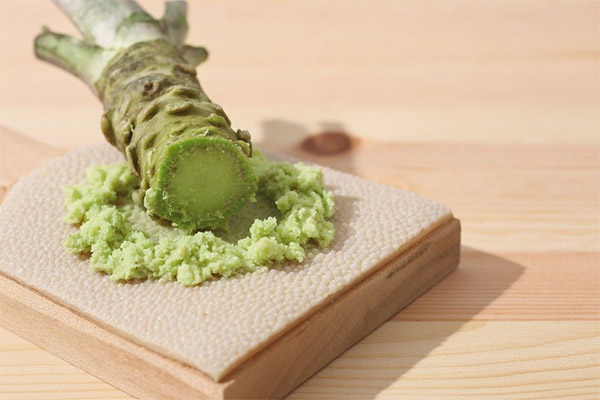
- Japanese horseradish has long been known to healers as a means of prolonging youth and bringing longevity.
- Cleansing the sinuses, getting rid of intestinal infections, an antidote for food poisoning - these are the possibilities of wasabi as a remedy.
- Fungal formations, staphylococcal infection, stomatitis, periodontal disease, malignant tumors - extracts and infusion from the Japanese root help get rid of these health problems.
- One of the main properties of rhizomes is the destruction of cancer cells and the prevention of their reproduction. The specific taste of the spice is the presence in it of isothiocyanates, natural antioxidants. They get in the way of metastasis, preventing damage to healthy cells. There is evidence of a complete cure for cancer in patients who regularly consumed wasabi.
- Seasoning is recommended by specialists in asthma, weakened immunity, and a decrease in potency.
- Joint pains, swelling will help cure compresses with Japanese spice.
- Asthma, anaphylactic shock recede under the influence of isothiocyanates in seasoning from a given root crop.
- The absence of caries in most Japanese experts is attributed to their active use of domestic natural spices.
- Normal cholesterol, prevention of platelet adhesion, improved blood flow, reduced risk of stroke and heart attacks - all these beneficial effects has wasabi on the human body. 1 tspseasoning daily helps in the treatment of thrombosis and myocardial infarction.
- One teaspoon of Japanese horseradish seasoning is 11% of the daily rate of ascorbic acid for a person. Spice has a beneficial effect on the body during periods of viral colds. It helps in the treatment of sore throat, cleansing the airways of mucus.
- The product does not allow a decrease in the number of white blood cells in the blood.
The healing qualities of Japanese root crops are used even in the modern world, despite the abundance of industrial medicines.
Wasabi in cosmetology
Prevention of rapid aging, the release of toxins, cleansing the body and skin, stimulating blood circulation - these are the requests of customers at SPA salons, where spice from Japanese root crops is used.
To save the client from cellulite, wasabi, orange extract, rosemary essential oil are mixed for wrapping.
The product is widely used in the manufacture of masks, shampoos, tanning products.
For face
Wasabi powder (in the amount of 2-3 tbsp), mixed with chicken yolk and a couple of teaspoons of rice flour and applied to the face, after 10 minutes will begin the smoothing and rejuvenation process. The warming and irritating properties of the burning spices in the mask help increase blood circulation and penetrate the beneficial substances found in the yolk. Rice flour smoothes the skin.
For hair
Wasabi in combination with ground ginger root in white wine strengthens hair and prevents hair loss. To prepare the product, both powders in an amount of 20 g are poured into hot wine in a container of dark glass. The mixture is aged in a warm place for 15-20 days. After the required time, the filtered liquid, depending on the sensitivity of the scalp, is diluted with freshly brewed green tea. The infusion is rubbed into the scalp and left for at least 3 hours, after which it is washed off. Already in the first minutes after applying the product, a sensation of a rush of heat and blood to the scalp comes.
Such a warming effect and the supply of hair follicles with useful substances gives a hair mask with wasabi (2 tbsp.), One yolk, 2 tbsp. sugar and a little honey. A similar product applied to the head is aged for at least one hour and is removed using warm water.
The use of wasabi in cosmetology is to obtain the desired effect if the rules are observed, since the severity of this seasoning can harm the skin.
Cooking use
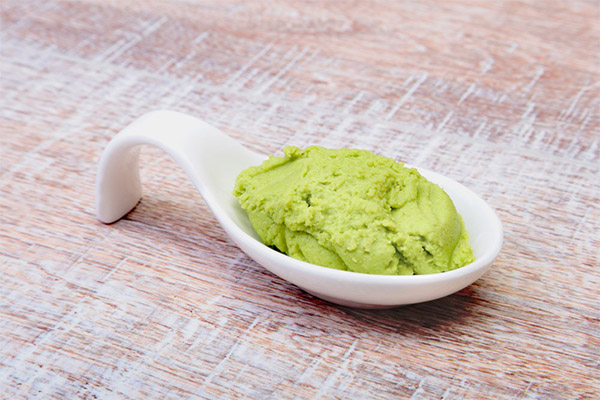
- Since the 14th century, the Japanese began to use all parts of the plant (root, leaves, stem and flowers) in cooking. Thanks to Japanese rolls and sushi, most lovers of delicious food learned about wasabi seasoning.
- First of all, this seasoning is necessary in raw fish dishes: the antibacterial and antifungal qualities of the paste make food safe.
- Salads and pickles taste better when wasabi is added.
- Chicken shish kebab takes on an unusual aroma when a root vegetable spice is added to the marinade. To do this, add olive oil, soy sauce, garlic to wasabi sauce. Sliced meat with such a mixture is baked in the oven. The shish kebab, infused for 10 minutes, will absorb aromas and a light burning spice.
- Tempura - a real Japanese dish with wasabi. It is golden in color with a crunch on the outside and delicate flesh on the inside. To do this, seafood and vegetables as part of onions, celery, sweet pepper, cut, dried and dipped in batter. Flour, eggs and ice water are the components of batter. After dipping in batter, the pieces are fried in boiling oil.
- The use of wasabi with fish, seafood, and rice is generally recognized and undeniable. Fried vegetables, shrimp, sushi and rolls with seasoning from Japanese root vegetables are often served.
- Spice has found application as an additive to first courses and soups. They from her presence acquire an exquisite aroma and pungency.
- Small fried fish served chilled with wasabi is considered a great appetizer.
- A sandwich, which is made from bread with a thin layer of this sauce, on which slices of smoked mackerel, cream cheese and a thin circle of tomato are arranged in layers, will satisfy the appetite of a seasoning lover with the versatility of hot-smoked taste.
- Wasabi is a component in creating original sauces and seasonings in combination with soy sauce, mayonnaise, mustard seeds.
- Japanese sauce is now "prescribed" in many restaurants in the world and is present in far from Japanese dishes.
- So, a salad of tomatoes - yellow, red, green received popularity. Wasabi, pine nuts, tarragon, green onions, salt, pepper and mascarpone (Italian cream cheese) are whipped. This mixture is seasoned with a salad of colorful tomatoes.
- For an amateur, they can offer a salad of green beans. For its dressing, a mixture is prepared in which walnut oil, ginger, rice vinegar, lime zest and mirin (sweet rice wine from Japan) are combined. After adding wasabi, beat the mixture. Refueling is ready.
- Amazing in taste, it turns out pork schnitzel, cooked with spice from Japanese horseradish. The meat is kept in the marinade for some time and baked in the oven.
- Brownies (chocolate cake) and pannacotta (boiled cream) - trendy desserts and sweet wasabi dishes. True, instead of root vegetable sauce, it is better to use a powdery analogue in the preparation of these delights.
How can you replace wasabi
Mixed mustard and horseradish can be used as a substitute for seasoning. But their aroma and pungency will not be so close to the original.
A fresh plant root is rare on sale. But spice manufacturers offer consumers wasabi powder, tablets, and paste in tubes.
Harm and contraindications
Nature for man has not created a single ideal, useful in all respects plants. The same can be said of wasabi.
- Excessive consumption of a product from this root crop can damage the liver. Hepatotoxin - a chemical element contained in a vegetable, in small doses does not pose any danger. But the liver begins to fail if this component accumulates: the body cannot cope with its processing.
- An increase in blood pressure can also lead to excessive seasoning.
- To avoid complications, people with signs of hepatitis, stomach ulcers, intestines, pancreatitis should limit the use of this spicy Japanese seasoning.
- An allergic reaction can also be a reason for cautious use of wasabi, especially for those who decide to try the product for the first time.
- With inflammatory processes in the kidneys, the use of seasoning is contraindicated.
How to choose and store wasabi
A root by that name is a very expensive pleasure. Most often it is replaced with horseradish, although it is inferior in properties to the "Japanese". Therefore, when choosing a product, you should be careful not to replace one with another, cheaper and low-quality.
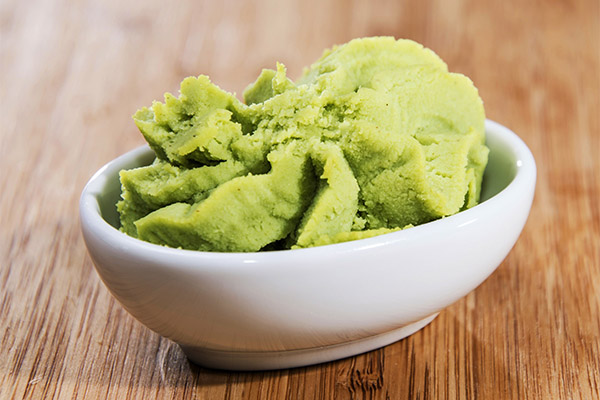
- If it is possible to choose a real wasabi root, then it should be fresh and unpeeled. When buying plant leaves, the same rule should be observed.
- The natural product is replaced by a paste from it, bright green and spicy. The composition should not be any additional components. Water, vegetable oil, E133, E102, mustard, preservatives, horseradish, flavor stabilizers - all this should be excluded from the product.
- A bona fide producer of wasabi powder will indicate the seasoning grade and percentage of the natural product on the packaging.
So, the first grade means the following: in the package 100% natural product.
20–25% of natural raw materials are contained in the second grade of the product.
The third grade is a complete wasabi substitute that is unlikely to be beneficial to health.
The refrigerator is the best place to store spices.This applies to natural root, paste and powder. The maximum shelf life of powder seasoning is one and a half years.
The shelf life of the sauce is small - only a few days, even subject to all the rules. Some manufacturers use additives to increase shelf life. Even with a shelf life of 24 months, the tube of paste should be in the refrigerator. An uncorked spice should be consumed within a few weeks.
The powder retains its properties much longer than the paste, if stored in a sealed container.
How to make wasabi at home
The product is prepared from fresh root, after peeling it from hard skin. On a fine grater in a circular motion rub as much paste as necessary for a single use. The remaining piece of raw material, wrapped in polyethylene, is placed in the refrigerator for no more than a month: it is for such a period that its taste, aroma and useful properties are preserved.
A single serving of wasabi from the powder is prepared in a ratio of 1 tsp. warm water and dried spices. A mixed clay color mixture after 10 minutes exposure will get a more pronounced taste and aroma.
A quite decent substitute for an exotic sauce can be seasoning in a purely Russian style. In terms of spiciness and taste, it will yield little to the "Japanese". Mustard powder, grated horseradish root, taken in equal proportions, for example, 50 grams, plus no more than 5 grams of green food coloring - and the Russian analogue of wasabi is ready.
Homemade wasabi mayonnaise is great for shrimp. To prepare it, beat the egg with 200 grams of vegetable oil. Diluted in warm boiled water to a paste-like state, the wasabi powder is combined with a beaten egg. After short mixing with a blender, add 1.5 tbsp. lemon juice, salt and pepper to taste. This dressing is suitable for other seafood dishes.
Japanese natural wasabi seasoning is not only an expensive product, but also very useful for people interested not only in delicious food, but also in good health.
Interesting Wasabi Facts

- Japanese herbalists used the healing properties of the root crop in the 7th century.
- First, the root of the plant was used to disinfect raw fish.
- The year 1908 is considered a reference time when the name of this root crop was first mentioned in one of the manuals on botany.
- World War II made seasoning a means that helped Europeans transport raw fish from Japan. Since that time, wasabi was appreciated in Europe not only as a component of many fish and meat dishes, but also as a means for health. True, the real Japanese spice is honwasabi, which is obtained from a very capricious vegetable that requires special growing conditions. Therefore, the seasoning known worldwide as wasabi is a product from European horseradish. Only a true gourmet can determine the difference between a real supplement and its substitute, of which there are not so many.
- Today, the price of a real wasabi is 200 euros per 1 kg of root.
- In 2011, Japanese experts invented a special type of alarm system that helps people who are hearing impaired during a fire escape: the pungent smell of a plant awakens a person sleeping or not hearing sounds.
- Among the many attractions of this mysterious country, eutrem flowers have taken their rightful place. Only on July 7, according to the Japanese, can you admire its colors. Since it is quite difficult to see them, it is believed that they will bring wealth and respect to the lucky one.
Wasabi is a miraculous plant, the sauce of which is not only an amazing seasoning. This is a unique remedy, the properties of which are still being studied by specialists. Perhaps in the near future, many new therapeutic agents will appear precisely thanks to wasabi.
«Important: all information on the site is provided exclusively in fact-finding purposes. Before applying any recommendations, consult with a profile specialist. Neither the editors nor the authors are liable for any possible harm caused materials. "

